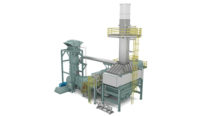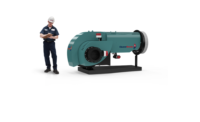
Indian
Summer replaced its old boiler system with a new Cleaver-Brooks CBLE, which
helped the plant increase production by 9% and decrease fuel usage by 32%.
Navigating the boiler upgrade and replacement possibilities and process
There are several catalysts that spark a discussion within a company about whether to upgrade or replace their steam boiler. Among the most common reasons are: a need to increase fuel efficiency, a requirement to decrease emissions, a heightened demand for steam, a process load decrease, or escalating maintenance costs on existing equipment.
The age of the boiler system is important to consider, but it should not be the key factor in the decisionmaking process. A more critical factor is the condition of a boiler’s pressure vessel. The shell, furnace, and tubes, which make up a boiler's body and venous system, are responsible for delivering heat energy from the burner into the water.
If an annual inspection of waterside and fireside surfaces shows minimal signs of heavy scaling, pitting, cracking, or stress, then the pressure vessel is probably in good shape and could deliver many more years of dependable life.
After determining the pressure vessel is acceptable, the next step is calculating the boiler’s efficiency. Using a flue-gas analyzer, check for the stack temperature over saturated temperature, the percent of oxygen (O2), carbon monoxide (CO), particulate, and nitrogen oxide (NOx) in the exit gas. If this analysis indicates high excess air (8% to 10% O2) in the mid- to high-fire ranges and CO in excess of 50 ppm, the burner will require a major tune-up, upgrade, or replacement.
The upgrade costs should be evaluated based on a boiler's expected life cycle. A life-cycle evaluation may reveal additional savings when a properly sized and controlled burner is fitted to a boiler's furnace for optimum radiant-heat transfer.
If the pressure vessel inspection determines the useful life has been depleted, all of the issues pertaining to boiler-replacement selection, including operational, physical, and financial concerns, need to be assessed. A boiler purchase needs to be evaluated on a true price/value basis.
KNOW THE FINANCIAL IMPACT OF YOUR DECISION
One software program now available to help aid in the upgrade vs. replacement decision is BOOST (Boiler Operation Optimization Savings Test). This program, available through Cleaver-Brooks representatives, details the annual cost savings to a company for making certain energy-efficient upgrades, retrofits or replacements.BOOST generates tailored reports that predict the efficiency calculation and associated dollar savings of replacing vs. upgrading current equipment. The reports also provide detailed financial analysis that shows a company’s after-tax savings, net present value (NPV), internal rate of return (IRR), and after-tax payback.
One company that recently used BOOST to determine whether to repair or replace its equipment is Indian Summer, manufacturer of apple juice and applesauce, located in Ludington, MI. The company was running three boilers between 100 to 300 hp, two of which were more than 30 years old. It had added more pasteurizers and filtration equipment to increase production, but according to Larry Morton, maintenance manager for Indian Summer, the boiler system was already maxed out.
Indian Summer contacted John Wallish at Dean Boiler in Grand Rapids, MI. Wallish met with executives at Indian Summer to understand the company’s goals and discovered that energy efficiency was top-of-mind for the company along with lowering emissions. The local utility company was offering rebates to manufacturers that made energy efficient upgrades; however, the decision for Indian Summer to buy new equipment had to be fiscally responsible in the long-run.
Dean Boiler ran BOOST reports for a number of upgrade vs. replacement scenarios. After analyzing the reports, Indian Summer purchased a Cleaver-Brooks CBLE 500-hp boiler with economizer, feed system, blow down heat recovery, and separator at a total project cost of $350,000 to $400,000. According to BOOST, the overall savings was projected to be $965,312 over a 10-year period with an estimated 18.9% reduction in overall energy expense and a 17% reduction in NOx emissions.
The BOOST analysis for Indian Summer was conducted with the expectation that the company would have to run one of its older boilers alongside the new system, but that has not been the case. According to Morton, “The new boiler runs the whole plant without any problem at all. We went from running three boilers to running one at ½ to ¾ throttle. It doesn’t even run wide open. It’s a world of difference.”
Shutting down the older boilers significantly increased the system’s efficiency and projected payback period. As a result, production has increased 9% and the plant is using 32% less fuel. Whereas, the initial payback period was projected to be 51 months, the company anticipates it will reach this mark in 32 to 37 months.
Installing a new boiler system was the right decision for Indian Summer. Today, there are many tools like BOOST available to help guide other companies facing the same decision. Take advantage of them to keep your company headed in the right direction. TB


